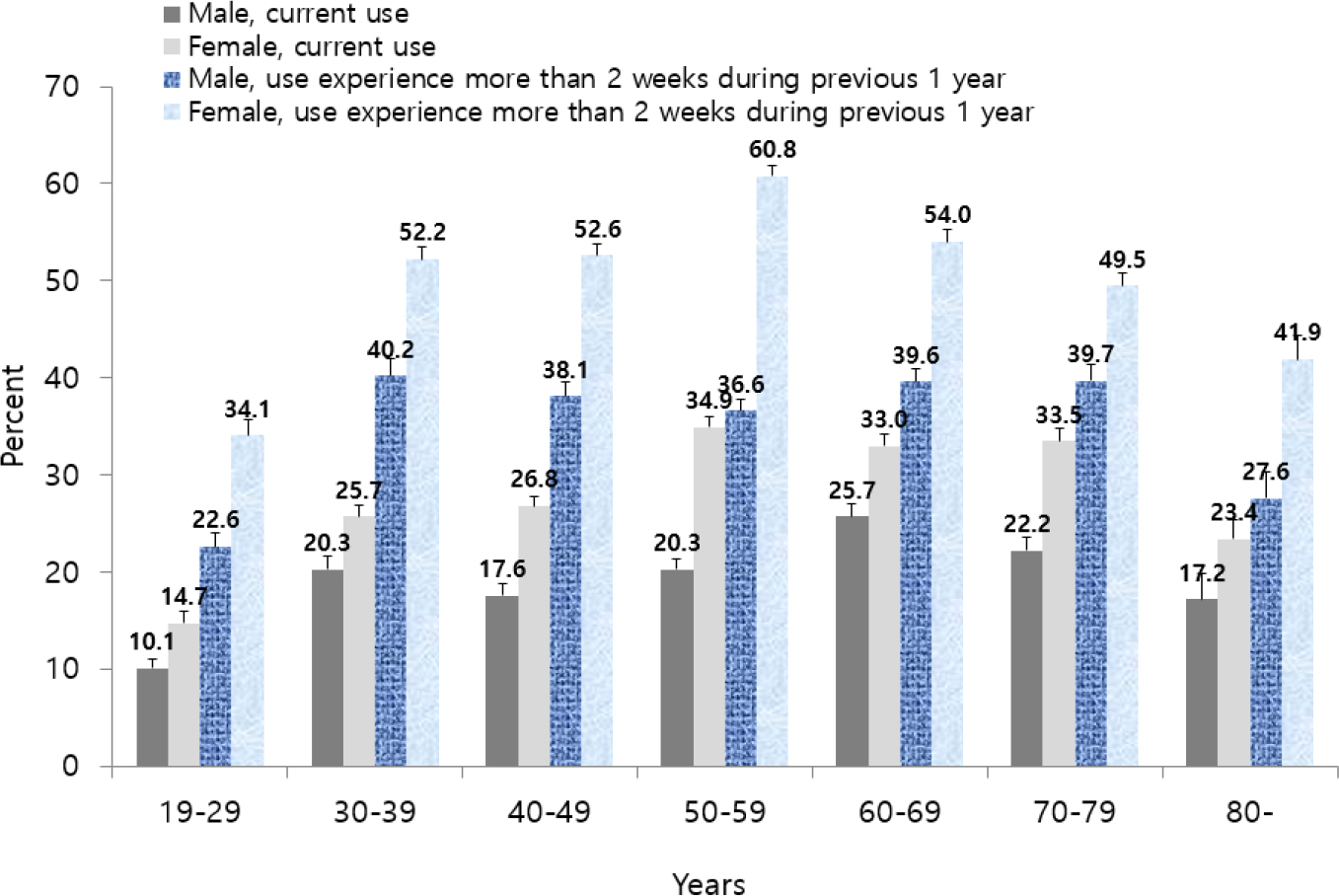Korean J Health Promot.
2018 Sep;18(3):107-112. 10.15384/kjhp.2018.18.3.107.
Which Types of Dietary Supplements Are Used in Korea? Data from the 2015 Korea National Health and Nutrition Examination Survey
- Affiliations
-
- 1Department of Family Medicine, Seoul Paik Hospital, University of Inje College of Medicine, Seoul, Korea. drparkhyunah@gmail.com
- KMID: 2421868
- DOI: http://doi.org/10.15384/kjhp.2018.18.3.107
Abstract
- BACKGROUND
The consumption of dietary supplements is increasing in Korea. The aim of this study is to assess the prevalence, types, and trends of dietary supplement (DS) use in Korean adults.
METHODS
We analyzed the Nutrition Survey data of Korean aged 19 years old or older from the 2015 Korea National Health and Nutrition Examination Survey. Two thousand and six hundred twenty one men and 3,324 women totaling 5,945 adults were included. The prevalence of DS use was calculated by two methods, i.e., consumption experience of more than two weeks during previous one year and current consumption. Each reported DS in the one day 24 hour recall was coded based on ingredients according to the 2016 Korean Food and Drug Administration Notification.
RESULTS
The prevalence (standard error) of current DS use was 18.4% (1.2) for men, 27.4% (1.1) for women. Those with DS use for longer than two weeks during previous one year were 35.2% (1.5), and 50.4% (1.2), for men and women respectively. Multi-vitamin mineral supplement (89.6/103 persons) was the most frequently consumed DS in Korean adults followed by vitamin C (66.2/103 persons), omega 3 fatty acid (49.5/103 persons), Panax ginseng (27.3/103 persons), and probiotics (22.2/103 persons) in listing.
CONCLUSIONS
The trend for DS use in Korean adults is changing as well as increasing. These factors should be considered in patient care.
Keyword
MeSH Terms
Figure
Cited by 2 articles
-
한국인에서 혈청 비오틴 농도
Sookin Moon, Eun Hye Cho, Seong Jun Park, Min-Jung Kwon, Hyosoon Park, Hee-Yeon Woo
Lab Med Online. 2022;12(3):191-194. doi: 10.47429/lmo.2022.12.3.191.Trends in cross-border shopping for dietary supplements in South Korea with a focus on major types of health functional foods
Youngmin Nam, Linxi Huang, Jong-Youn Rha, Bongwon Suh, Jihyun Yoon
Nutr Res Pract. 2025;19(2):241-256. doi: 10.4162/nrp.2025.19.2.241.
Reference
-
References
1. Ministry of Health and Welfare. 2016 Korea Helath Statistics II. 2017.2. Korea Agency of HACCP Accreditation and Services. 2017 Korea domestic market trend analysis of the dietary supplements use. 2017.3. Yi HH, Park HA, Kang JH, Kang JH, Kim KW, Cho YJ, et al. What types of dietary supplements are used in Korea? Data from the Korean National Health and Nutritional ExaminationSurvey 2005. Korean J Fam Med. 2009; 30(12):934–43.4. Park HA. Top 10 dietary supplements of Korean adults from the 4th Korea national health and nutrition examination survey. Korean J Fam Med. 2011; 32(4):263–6.
Article5. Korea Food & Drug Administration. Manual for KFDA notification (No. 2016–143) Health Functional Food. 2016.6. Li K, Kaaks R, Linseisen J, Rohrmann S. Consistency of vitamin and/or mineral supplement use and demographic, lifestyle and health-status predictors: findings from the European Prospective Investigation into Cancer and Nutrition (EPIC)-Heidelberg cohort. Br J Nutr. 2010; 104(7):1058–64.
Article7. Korea Food & Drug Administration. Recognition on the functionality of ingredients of the health fuctional food. 2016.8. Age-Related Eye Disease Study 2 Research Group. Lutein + zeaxanthin and omega-3 fatty acids for age-related macular degeneration: the Age-Related Eye Disease Study 2 (AREDS2) randomized clinical trial. JAMA. 2013; 309(19):2005–15.9. National Evidence-based Healthcare Collaborating Agency. The clinical effectiveness of glucosamine and chondroitin therapy in treating patients with osteoarthritis. 2010.10. Kim M, Lee Y, Park K. Vitamin and mineral supplement use among korean adults: baseline data from the trace element study of Korean adults in yeungnam area. Nutrients. 2018; 10(1):E50.
Article11. Rock CL. Multivitamin-multimineral supplements: who uses them? Am J Clin Nutr. 2007; 85(1):277S–9S.
Article12. Lin JR, Lin YS, Kao MD, Yang YH, Pan WH. Use of supplements by Taiwanese adults aged 19-44 during 2005–2008. Asia Pac J Clin Nutr. 2011; 20(2):319–26.
- Full Text Links
- Actions
-
Cited
- CITED
-
- Close
- Share
- Similar articles
-
- Top 10 Dietary Supplements of Korean Adults from the 4th Korea National Health and Nutrition Examination Survey
- Evaluation of the Nutritional Status according to Household Type and Dietary Supplements Consumption in Korean Elderly: Using 7th (2016∼2018) the KNHANES Data
- What Types of Dietary Supplements Are Used in Korea? Data from the Korean National Health and Nutritional Examination Survey 2005
- Use of Dietary Supplements and Determinants of Taking Dietary Supplements by Gender in the Korean Population: Using the 4(th) Korean National Health and Nutrition Examination Survey (2007-2009)
- Use of vitamin and mineral supplements and related variables among university students in Seoul



